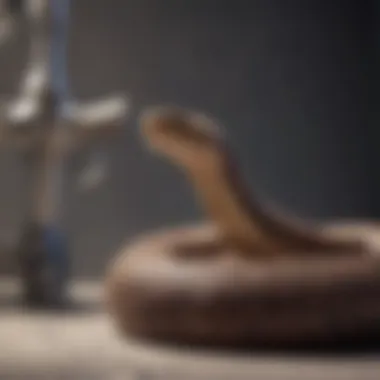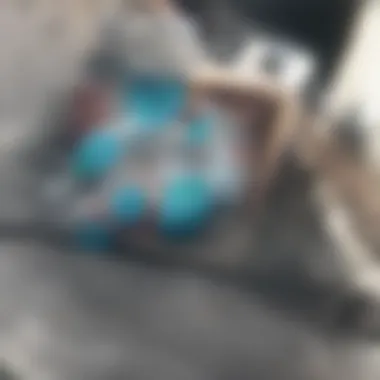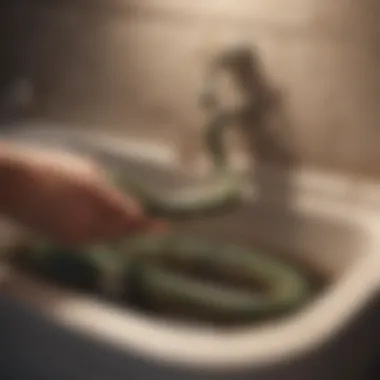Effective Hair Removal from Drains Using a Snake


Intro
Household plumbing issues can be a significant inconvenience. One of the most prevalent problems is hair accumulation in drains. Over time, hair, along with soap residue and other debris, can contribute to frustrating blockages. Utilizing a snake, specifically a plumbing snake, is a tried and tested method to alleviate these issues. This guide provides a thorough overview of how to effectively use a plumbing snake for hair removal from drains.
Key Topics of Discussion:
- Types of plumbing snakes
- Techniques for optimal use
- Preventive measures for future blockages
- Maintenance of plumbing systems
Understanding these aspects can empower homeowners. Moreover, having the right knowledge minimizes the risk of costly repairs. This guide is not just for seasoned DIY enthusiasts; even a novice can gain insights to maintain efficient plumbing systems. Let's explore this further.
Preface to Drain Blockages
Drain blockages can lead to significant inconvenience and damage within a home. Understanding this topic is crucial as it not only addresses the symptoms but also dives into the root causes of these plumbing issues. When water fails to drain properly, it may signal an underlying problem, which must be rectified to maintain efficient usage of your plumbing system.
By comprehending the dynamics around drain blockages, homeowners can take proactive steps to mitigate issues before they escalate. This guide will emphasize practical solutions, one of which involves utilizing a plumbing snake effectively. Such knowledge not only enhances your residential upkeep skills but also contributes to the longevity of your plumbing systems.
Understanding Common Causes
Many factors contribute to drain blockages. One prevalent cause is the accumulation of debris, which can include anything from food particles to bathroom products. Additionally, foreign objects introduced into the plumbing system can easily cause blockage. It is vital to recognize these factors to implement preventative measures.
Common culprits for blockages include:
- Grease and Fat: These substances can solidify in pipes, trapping debris and forming clogs.
- Hair: Particularly in bathrooms, hair can accumulate and create significant blockages.
- Soap Scum: Residue from soaps and shampoos can congeal and build up over time.
- Tree Roots: In older plumbing, roots can intrude and grow into pipes, causing severe blockages.
Understanding these causes equips homeowners to manage routine inspections and maintenance better, ultimately avoiding hassle and costly repairs.
The Role of Hair in Drain Clogs
Hair is a primary suspect in drain blockages, especially in bathroom sinks, showers, and bathtubs. Its lightweight and fibrous nature make it easy to become entangled with other materials, leading to a build-up that can obstruct drainage.
In most cases, hair sheds naturally; however, it can become problematic when it accumulates in the pipes. Over time, hair can clump together with soap residue and other debris, creating a dense mass that completely obstructs water flow. The presence of hair not only slows down drainage but can also lead to a backup, risking water damage and unpleasant odors in the home.
Regular cleaning and the use of hair strainers can help prevent hair from escalating into a larger issue. Understanding its contributing role in drain clogs helps homeowners take proactive measures.
What is a Plumbing Snake?
A plumbing snake plays a vital role when addressing drain clogs. It is an essential tool designed specifically for clearing blockages in household plumbing, particularly those caused by hair accumulation. Understanding what a plumbing snake is and how it functions provides homeowners with the ability to handle a common yet frustrating issue effectively.
Definition and Functionality
A plumbing snake, also known as a drain snake or auger, is a flexible tool that maneuvers through plumbing pipes. Its primary function is to dislodge and remove debris that causes drain clogs. The snake is equipped with a coiled metal or plastic wire that can bend around curves and reach deep into the plumbing system. By twisting and pushing this tool, users can extract hair and other materials that obstruct the flow of water. The effectiveness of a plumbing snake comes from its ability to penetrate the tight spaces within pipes, where other cleaning methods may not reach.
Types of Plumbing Snakes
Plumbing snakes come in various types, each suited for different tasks and drain conditions. Choosing the appropriate type significantly enhances the efficiency of removing hair from drains.
Manual Snakes
Manual snakes are hand-operated tools that often consist of a long, flexible cable with a hand crank. The key characteristic of manual snakes is their simplicity and ease of use. These snakes are often considered a beneficial choice for small and medium household drains.
Advantages:
- Cost-effective and readily available.
- No need for electricity, making them usable in various locations.
- Suitable for beginners due to their straightforward operation.
Disadvantages:


- Require physical effort to use, which may be tiring for some users.
- Less effective for deep clogs compared to powered options.
Electric Snakes
Electric snakes, also known as power augers, automate the process of clearing drain clogs. These tools are equipped with an electric motor that rotates the cable at high speeds.
The key characteristic of electric snakes is their ability to handle tougher blockages with minimal user effort. They are popular for professional plumbing services and among those who frequently encounter severe clogs.
Advantages:
- More powerful and effective for severe clogs.
- Reduces the physical exertion required during use.
Disadvantages:
- Higher initial investment compared to manual snakes.
- Requires access to an electrical outlet while in use.
Drain Augers
Drain augers are a specialized type of plumbing snake designed for larger pipes, such as those found in commercial settings. They feature a sturdier construction to handle more demanding tasks.
The unique feature of drain augers lies in their ability to manage large volumes of debris, making them suitable for significant plumbing issues.
Advantages:
- Excellent for heavy-duty applications in both residential and commercial settings.
- Can handle blockages in bigger drains effectively.
Disadvantages:
- Size and weight can make them cumbersome for small jobs.
- Generally more expensive than standard plumbing snakes.
By understanding the various types of plumbing snakes available and their distinctive features, homeowners can make informed choices on which tools to utilize for hair removal from drains. In turn, this knowledge empowers them to maintain their plumbing system effectively.
Selecting the Right Snake for Hair Removal
Choosing the right plumbing snake is critical for effective hair removal from drains. It directly impacts the efficiency and success of the cleaning process. Not all snakes are created equal; understanding the specific needs and limitations of each type ensures homeowners can tackle drain blockages effectively, ultimately saving time and money.
Key Considerations
Diameter Compatibility
When selecting a plumbing snake, the diameter compatibility is crucial. Most household pipes have standard diameters, usually between 1.25 inches and 3 inches. Choosing a snake that matches this diameter allows for smooth navigation through the pipes. A well-matched diameter enhances the snake's ability to remove hair and debris effectively. If the snake is too wide, it may not fit, whereas a narrow one could lack the strength needed for effective clearing. Therefore, ensuring diameter compatibility can lead to a more successful and less frustrating experience in drain maintenance.
Length Requirements
Length requirements of a plumbing snake also play a significant role. Most blockages occur deep within the plumbing system. A snake that is too short will not reach these clogs. Typically, household snakes range from 15 to 100 feet in length. For regular maintenance, a shorter snake may suffice, but for more severe blockages, longer options are more effective. By understanding one's plumbing system's depth, homeowners can choose the appropriate length for optimal effectiveness when addressing hair build-up in drains.
Flexible Options
Flexibility is another important aspect of a plumbing snake. Many models offer a degree of flexibility, which allows them to navigate bends and turns in the plumbing system. Flexible snakes can reach deeper into the drain, making them particularly beneficial for tight spaces. However, too much flexibility can reduce a snake's power, making it less effective at dislodging stubborn clogs. Hence, striking a balance between flexibility and effectiveness is vital for homeowners to consider when purchasing a plumbing snake.
Recommendations for Home Use
Selecting the right snake involves not only the technical specifications but also practicality for home use. Homeowners should consider their plumbing system's particular needs. For instance, a manual snake could suffice for minor blockages, while an electric snake may be necessary for more stubborn clogs. Choosing a reliable brand with positive reviews can also provide confidence in the product's efficacy.
Furthermore, investing in a versatile model that covers various pipe sizes and lengths can offer long-term value. For convenience, having a plumbing snake that comes with an instructional guide or video can simplify the process for those unfamiliar with the equipment. This preparation ensures safer and more efficient use.


Preparation for Safe Use
Preparation is essential before using a plumbing snake for cleaning drains. Proper preparation sets the foundation for effective hair removal, ensuring safety and enhancing efficiency. Taking time to gather tools and clear the area helps in achieving a smoother process.
Gathering Necessary Tools
Before starting, you will want to ensure you have all necessary tools for the task. This leads to a more organized approach when using the plumbing snake. Here are the essential items:
Gloves and Safety Gear
Gloves serve a critical role in protecting your hands from contaminants and sharp debris. High-quality rubber gloves are a popular choice as they provide an excellent barrier against dirt and bacteria. A vital characteristic of gloves is their durability, ensuring they do not easily tear during use. This safety gear not only keeps your hands safe but also contributes to maintaining hygiene during the cleaning process. Without them, you risk direct exposure to harmful substances.
Bucket for Debris
A reliable bucket is important for collecting any debris removed from the drain. Having a dedicated container helps in managing waste and keeps the work area tidy. One key characteristic of a bucket is its size; a larger bucket allows for more debris to be collected without needing frequent emptying. By using a bucket, you can easily dispose of the waste, preventing any mess in the surrounding area. However, choosing a bucket that is too small could hinder your efficiency, as you may have to stop often to remove debris.
Flashlight for Visibility
Good visibility is crucial when working with a plumbing snake. A flashlight ensures you can see into the drain clearly, helping to locate the clog. A key detail of a flashlight is its brightness and battery life; an excellent choice is one that has adjustable brightness options and long-lasting batteries. This portable tool illuminates dark and confined spaces, minimizing the risk of accidents while improving the overall effectiveness of your work. Without adequate lighting, it can be easy to miss obstructions, prolonging the time needed for unclogging your drains.
Rinsing and Clearing the Area
Before using any tools, it’s important to tidy the immediate area around the drain. Rinsing the area reduces mess and ensures that you can work without distractions. This not only improves focus but also maintains a neat workspace. Clear any nearby items or obstacles to avoid accidentally damaging them during the process.
Taking these preparatory steps significantly enhances the overall effectiveness of your task. By organizing your tools and workspace, you increase the likelihood of a successful outcome.
Step-by-Step Instructions
The process of using a plumbing snake for hair removal from drains is systematic. Following each step carefully ensures effective results while minimizing potential mishaps. This section outlines the necessary actions to achieve clean drains, taking into account the unique challenges of hair clogs.
Opening the Drain Access
Before employing the snake, the first step involves accessing the drain. This typically means removing the drain cover or plug. Use a screwdriver or appropriate tool to take off any screws, ensuring you don’t damage the drain fixture. Having access to the drain means maximizing the snake's effectiveness as it can reach deeper obstructions. Take care in lifting off the cover gently; this prevents any breakage, allowing for easier maintenance in the future.
Inserting the Snake
Once the drain is open, the next task is inserting the snake. Hold the snake firmly and feed the end into the drain opening. It's crucial to keep steady pressure while inserting to avoid jamming the snake. You may have to turn or twist the snake slightly as you push it into the drain. This allows the snake to navigate bends and curves. A common mistake is to apply too much force, which can make the situation worse by pushing the clog further down.
Navigating the Snake through the Drain
As you continue to insert the snake, feel for any resistance. If you encounter a blockage, do not panic. This is where the snake's design proves useful. Slowly rotate the handle or turn the snake to penetrate the clog. It is important to be patient during this step; abrupt movements can lead to further complications. Keep track of how far you have inserted the snake, as this will assist with retrieval later.
Retrieving Hair and Debris
When you feel the snake breaking through the blockage, start to pull it back out carefully. This is often where the hair and debris becomes visible. You will likely notice hair wrapped around the coils of the snake. Remove these clogs with your gloves to avoid direct contact. The importance of clear disposal methods cannot be stressed enough at this point, as it is essential to keep your work area clean. By ensuring that debris is properly disposed of, you can work more efficiently and maintain a sterile environment.
Testing Drain Functionality
Finally, once the hair and debris are removed, it is critical to test the drain’s functionality. Run water through the drain to ascertain whether the clog has cleared. Observe how quickly the water drains. A properly functioning drain will have no pooling water. If you find the water level continues to rise, further investigation may be needed. Using a snake is effective, but there are instances when professional help becomes necessary.
Regular maintenance and prompt attention to drain issues can prevent significant problems later.
Following these instructions carefully allows for successful hair removal and enhances your plumbing skills. It is a cost-effective solution that enables homeowners to tackle minor plumbing issues without professional assistance.
Post-Cleaning Considerations


After successfully removing hair and debris from your drains, it's essential to consider the next steps to ensure optimal functionality and longevity of both your plumbing and your plumbing tools. Post-cleaning steps are often overlooked, but they play a crucial role in maintaining a clean and efficient plumbing system. Addressing the disposal of debris and the cleaning and storage of the plumbing snake will help enhance your overall plumbing maintenance practices.
Proper Disposal of Debris
Disposing of debris responsibly is a fundamental aspect of post-cleaning. After you extract hair and other materials from the drain, it is vital to dispose of these contaminants appropriately. This is not just about keeping your space clean; improper disposal can create secondary issues.
- Avoid Flushing Debris: Do not attempt to flush hair or other waste down the toilet. This can lead to additional clogs further down the line.
- Use a Plastic Bag: Place the collected debris into a sealed plastic bag. This method contains odors and prevents any mess from spilling.
- Dispose in Trash: The best practice is to dispose of the bag in your regular trash. By doing this, you keep the wastewater treatment system functioning effectively and mitigate pollution risks.
"Proper disposal of drain waste not only promotes hygiene but also preserves the efficiency of your plumbing system."
- Consider Composting: If you are inclined to explore eco-friendly options, consider where applicable, but remember that human hair can break down in compost. Evaluate your local regulations and guidelines regarding composting.
Cleaning and Storing the Snake
Once the debris is disposed of, the plumbing snake needs attention. Cleaning and storing the snake correctly not only prolongs its lifespan but also ensures it’s ready for the next use.
- Cleaning the Snake: After use, it is advisable to wash the snake thoroughly. Here’s how:
- Dry Before Storing: Moisture can lead to rust or corrosion. Allow the snake to dry completely before storage.
- Proper Storage Location: Store the snake in a dry location, preferably in a case or wrapped in plastic. Keeping it organized and secure protects it from damage and ensures it remains usable.
- Rinse the snake in warm water to remove hair and debris.
- Use a cleaning agent if necessary. Mild soapy water generally suffices.
- Wipe down the surface with a cloth to ensure no remaining particles stick to it.
By being conscientious about the post-cleaning process, homeowners can enhance their plumbing practices. This attention to detail reflects an understanding that maintenance is a continuous process, rather than a one-off task.
Preventative Measures for Future Issues
Preventative measures hold significant value when it comes to maintaining the functionality of drainage systems in your home. Engaging in regular maintenance not only prolongs the life of your plumbing but also reduces the likelihood of sudden blockages. Addressing the underlying causes of clogs is essential to mitigate future problems, particularly those caused by hair and other debris. This section will explore key strategies to prevent drain blockage before it becomes a costly inconvenience.
Regular Maintenance Practices
Regular maintenance is crucial in ensuring drain systems operate smoothly. Here are some effective practices:
- Routine Inspections: Conducting regular check-ups can reveal early signs of clogs. Inspect visible pipes for any signs of buildup or leaks.
- Hot Water Disposal: Pouring hot water down the drain once a week helps to dissolve fats and oils that could accumulate over time.
- Baking Soda and Vinegar: This mixture is a natural cleaner. Use it monthly to help break down organic matter.
- Flush with Water: After any potential buildup, run hot water through your pipes to ensure everything flows down properly.
Hair Strainers and Drain Covers
Installing hair strainers or drain covers is a simple yet effective strategy to keep clogs at bay. These devices can significantly reduce hair and debris from entering your drainage system. Their implementation has numerous benefits:
- Cost-effective: Hair strainers are affordable and easy to install, providing long-term savings on plumbing repairs.
- User-friendly: They can be easily removed for cleaning, making maintenance simple and hassle-free.
- Versatile Options: They come in different styles and designs, suitable for various types of drains, from bathtubs to kitchen sinks.
"An ounce of prevention is worth a pound of cure."
Incorporating such preventative measures not only ensures effective drainage but also enhances overall home upkeep. These practices are vital for preserving the integrity of your plumbing system while also empowering homeowners with proactive maintenance techniques.
End
The conclusion of an article serves as a vital component. It encapsulates the significance of using a plumbing snake for hair removal from drains, emphasizing key points discussed throughout. The importance lies in several specific elements. First, using a plumbing snake effectively addresses a common household issue: drain blockage caused by hair. Homeowners often face this problem, leading to costly repairs if not dealt with promptly.
Another benefit is the empowerment of individuals. By encouraging readers to utilize a snake, they learn valuable skills in maintaining their plumbing systems. This can promote a sense of self-sufficiency and reduce reliance on professional plumbers for minor issues. Understanding the operation of a plumbing snake enhances knowledge of home maintenance, making it easier to handle future problems.
Furthermore, implementing preventive measures post-cleaning helps in reducing the frequency of such blockages, ensuring long-term efficiency. Regular maintenance can save both time and money in the long run. Overall, the conclusion ties together the lessons learned and the importance of being proactive in home care.
Summary of Key Points
- Blockages from hair in drains are common and manageable.
- A plumbing snake offers a practical solution for removing hair and debris.
- Selecting the right type of snake is essential based on drain size and accessibility.
- Proper preparation and execution during the cleaning process are crucial.
- Post-cleaning care and preventive measures are necessary to maintain drain functionality.
- DIY plumbing solutions can empower homeowners and reduce future costs.
Encouragement for DIY Solutions
It is important to encourage homeowners to embrace DIY solutions. Using a plumbing snake is a task that many can accomplish with a little guidance. It can be seen as a small yet impactful way to take control of home maintenance. Every time a person tackles a minor household problem like a clogged drain, they grow more confident in their capabilities.
DIY approaches also offer educational benefits. Individuals learn about their home's systems and how to care for them. This knowledge can foster a greater understanding of plumbing mechanics. By taking time to learn these skills, homeowners not only save money but also mitigate the stress of unexpected plumbing issues.
Ultimately, recognizing the value of self-reliance in home maintenance tasks such as drain cleaning contributes to long-term satisfaction in home ownership.



